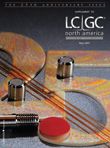Corporate Retrospective 2007: Agilent
Congratulations to LCGC North America on 25 illustrious years covering the fields of separation science and analytical instrumentation.
Congratulations to LCGC North America on 25 illustrious years covering the fields of separation science and analytical instrumentation. The growth of this influential magazine since its founding in 1983 parallels HP/Agilent's emergence as a leading supplier of analytical systems in the industry. We've grown side by side during this eventful quarter century.

HP/Agilent's most significant contributions to the industry began in 1983 by the introduction of a bench-top GC–MS system, followed in 1984 with the introduction of the best-selling gas chromatograph ever. This was followed by the 1994 introduction of the world's first benchtop ICP–MS system for trace metal analysis; the 1995 launch of the stackable LC systems; the 1996 introduction of a bench-top LC–MS system; and Agilent's 2005 introduction of the microfluidic HPLC.
But we began our journey long before these events. Agilent Technology's Life Science and Chemical Analysis business can be traced back to HP's purchase of F&M Scientific in 1965 and the purchase of Hupe Busch in 1973. From this modest start we have built a strong chromatography and bench-top MS business by developing solutions to meet customer and industry needs, and delivering value based on advanced technology and industry-leading reliability. As a result of this focus, today we enjoy global market leadership in GC, LC, GC–MS, LC–MS, and ICP–MS bench-top instruments, as well as in GC columns.
Industry trends and customer needs continue to drive us to new business innovations, and we are focused to remain at the top of the game. I think that our leadership in high-throughput systems will continue as we continue to improve workflow solutions for customers in our target markets. We believe that the HPLC-chip technology is disruptive and has the potential to revolutionize sample preparation and analysis in the years ahead. Finally, software continues to be a key driver for lab productivity, and our investments in this area are focused on advanced workflow and laboratory optimization for customers in our target markets.
To everyone at LCGC, here's to another quarter century of remarkable and mutual progress and growth!

Chris van Ingen
Chris van Ingen
President, Life Sciences and Chemical Analysis
Agilent Technologies
Santa Clara, California

Determining Neurotransmitters in Spinal Cords with UHPLC
February 18th 2025Researchers at Jilin University (Changchun, China) developed a highly sensitive, rapid, and accurate method for analyzing neurotransmitters (NTs) in rat spinal cord tissue. Ultra-high performance liquid chromatography-triple quadrupole tandem mass spectrometry (UHPLC-QqQ-MS/MS) in conjunction with ultra-ionic liquid dispersive liquid-liquid microextraction (UA-MIL-DLLME) were used to extract NTs for analysis.
The Next Frontier for Mass Spectrometry: Maximizing Ion Utilization
January 20th 2025In this podcast, Daniel DeBord, CTO of MOBILion Systems, describes a new high resolution mass spectrometry approach that promises to increase speed and sensitivity in omics applications. MOBILion recently introduced the PAMAF mode of operation, which stands for parallel accumulation with mobility aligned fragmentation. It substantially increases the fraction of ions used for mass spectrometry analysis by replacing the functionality of the quadrupole with high resolution ion mobility. Listen to learn more about this exciting new development.
Revolutionizing LC-MS with Next-Gen Separation for Cyclic Peptide Analysis
February 17th 2025Cyclic peptides, known for their stability and high specificity, are promising therapeutic agents in the fight against cancer, infections, and autoimmune diseases. However, developing effective cyclic peptides presents numerous challenges, including poor pharmacokinetics, efficacy, and toxicity. Traditional methods like liquid chromatography tandem-mass spectrometry (LC-MS/MS) often struggle with resolving isomeric linear peptide metabolites, posing significant risks in safety, efficacy, and regulatory approval. In this paper, Komal Kedia, PhD, will share how she leveraged MOBIE’s high-resolution ion mobility-mass spectrometry (IM-MS) system to achieve a 72% reduction in run times, 200% greater resolving power, and enhanced accuracy in identifying “soft spots” prone to enzymatic degradation.
























